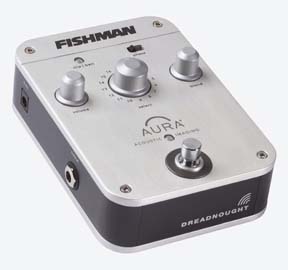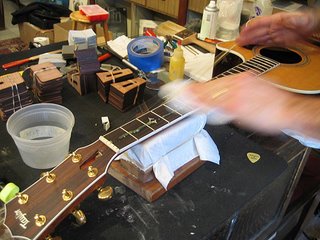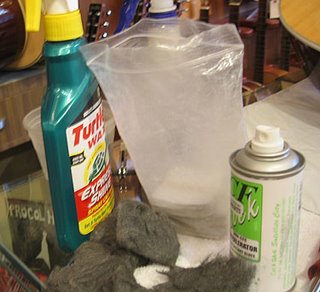
I went to a
Taylor Guitars Road Show last night at
Acoustic Outfitters near Portsmouth NH.
Whether you already own a Taylor, or are thinking of getting one, it was a great event to catch up on the things Taylor is doing. They brought along about 12 different models that people could try and that were on sale (at a good discount; but not give-away prices!)
The event started off with an explanation of the ES system complete with a cut-away – no back – guitar, and then they did a demo of the effects of different kinds of wood; they had four GC models constructed with different top and back woods and talked about the sound differences. Next they demoed different body shapes. A T5 demo explained the differences between the 5 different pickup settings.
Finally a guitar tech did a quick care and feeding demo (and he also did some inspections and adjustments on guitars people had brought in with them during the break.) At the end they gave away some t-shirts and picks. All-in-all a fun evening, and while it wasn’t quite like going to the Factory, it was a good event to learn about their products.
Things I learnt:
They can neither confirm or deny the existence of an
ES system for nylon string guitars; the problem is that you can’t use a bridge pick-up with nylons strings, but they may have a solution coming.
Their
custom shop currently takes 60 days. Also, they will be offering later this year an online custom order tool that will let you go in and choose different options. How this will work with relation to dealers (I’m assuming you won’t just order straight from the factory) was not explained.
If you send a picture of your T5, they’ll try and match the wood to make a matching T-5 12 string!
Someone asked about
R.Taylor, and they basically said that it’s a completely separate operation to Taylor Guitars. They do share technical knowledge, but marketing etc is completely separate. Also, they only build about 300 guitars a year, which is why not all Taylor dealers are R. Taylor dealers (given that they have about 500 Taylor dealers.)
They will be coming out with
Australian Blackwood limited editions in the Fall. These will be announced at NAMM.
Someone asked
why the GC models have slot heads. It sounded like one of the big motivations was to distinguish the models for buyers, though they also mentioned that they are considered “more traditional” in appointment and they are short scale.
Taylor doesn’t stain their ebony
They are
working on a cut-away for the GS models. The GS was described as a replacement for the Jumbo; the Jumbo sound without the Jumbo size. But the dimensions are very similar to the popular GA. They want the cutaway GS to look different to a GA.
Several changes made in construction were noted. This included the relief cut; a channel cut in the sound board near the out edge of the sound board, and also that they are moving towards using different thicknesses in woods depending upon the type and density of the wood. The latter started happening this year.
The
T5 12 string has a new compensated bridge that adjusts for the different thicknesses of the different sets of strings.
Oh, and there will be a
new solid-body electric at NAMM; though they cannot confirm or deny that.
 Another Beatles book.
Another Beatles book.




























